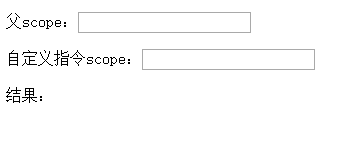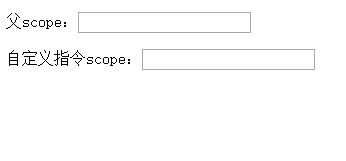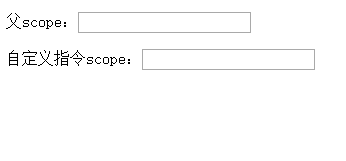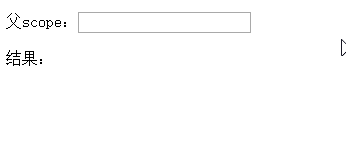AngularJS自定義指令directive:scope屬性
阿新 • • 發佈:2019-01-04
一、介紹:
在AngularJS中,除了內建指令如ng-click等,我們還可以自定義指令。自定義指令,是為了擴充套件DOM元素的功能。程式碼中,通過指定directive中的restrict屬性,來決定這個指令是作為標籤(E)、屬性(A)、屬性值(C)、還是註釋(M)。
二、scope屬性的3種取值:
說明:為了探究scope取值對指令的影響,這裡舉的例子中,自定義指令都是作為DOM的tag使用的,即restrict屬性為“E”。指令的名稱為“my-directive(myDirective)”。
1、false(預設值):直接使用父scope。比較“危險”。
可以理解成指令內部並沒有一個新的scope,它和指令以外的程式碼共享同一個scope。例子:
(1)指令的定義,app.js:
app.directive('myDirective', function() {
return {
restrict: 'E',
replace: true,
templateUrl: '../templates/my_template_01.html',
scope: false, // 預設值
controller: null
}
});(2)指令模板,my_template_01.html:
<div>
<!--這裡ng-model繫結的input,就是父scope的變數input--> (3)指令的使用,index.html:
<body ng-app="watchDemo" ng-controller="controller01">
<p>父scope:<input type="text" ng-model="input"></p>
<!--自定義指令--> (4)效果:
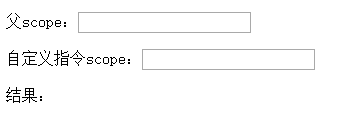
可以看到,因為是同一個scope,所以無論是改變my-directive裡面還是外面的輸入框中的文字,都會改變這個scope中的“input”的值。
2、true:繼承父scope
(1)指令的定義,app.js:
app.directive('myDirective', function() {
return {
restrict: 'E',
replace: true,
templateUrl: '../templates/my_template_01.html',
scope: true, // 只是改動了這裡
controller: null
}
});(2)指令模板,my_template_01.html:
<div>
<!--這裡繫結的同名的input,在繼承的(子)scope中-->
<p>自定義指令scope:<input type="text" ng-model="input"></p>
<p>結果:{{input}}</p>
</div>(3)指令的使用,index.html,沒有變動:
<body ng-app="watchDemo" ng-controller="controller01">
<p>父scope:<input type="text" ng-model="input"></p>
<!--自定義指令-->
<my-directive></my-directive>
</body>(4)效果:
一開始是繫結在父scope中,但當修改位於自定義指令中的輸入框時,子scope就被建立並繼承父scope了。之後,修改父scope並不能影響input的值,而修改子scope就可以改變input的值了。如圖:
3、{ }:建立一個新的“隔離”scope,但仍可與父scope通訊
隔離的scope,通常用於建立可複用的指令,也就是它不用管父scope中的model。然而雖然說是“隔離”,但通常我們還是需要讓這個子scope跟父scope中的變數進行繫結。繫結的策略有3種:
- @:單向繫結,外部scope能夠影響內部scope,但反過來不成立
- =:雙向繫結,外部scope和內部scope的model能夠相互改變
- &:把內部scope的函式的返回值和外部scope的任何屬性繫結起來
(1)@:單向繫結
示例程式碼:
<body ng-app="watchDemo">
<!--外部scope-->
<p>父scope:<input type="text" ng-model="input"></p>
<!--內部隔離scope-->
<my-directive my-text="{{input}}"></my-directive>
<script>
var app = angular.module('watchDemo', []);
app.directive('myDirective', function () {
return {
restrict: 'E',
replace: true,
template: '<p>自定義指令scope:<input type="text" ng-model="myText"></p>',
scope: {
myText: '@'
}
}
});
</script>
</body>效果:
(2)=:雙向繫結
示例程式碼:
<body ng-app="watchDemo">
<!--外部scope-->
<p>父scope:<input type="text" ng-model="input"></p>
<!--內部隔離scope-->
<!--注意這裡,因為是雙向繫結,所以這裡不要“{{}}”這個符號-->
<my-directive my-text="input"></my-directive>
<script>
var app = angular.module('watchDemo', []);
app.directive('myDirective', function () {
return {
restrict: 'E',
replace: true,
template: '<p>自定義指令scope:<input type="text" ng-model="myText"></p>',
scope: {
myText: '=' // 這裡改成了雙向繫結
}
}
});
</script>
</body>效果:
(3)&:內部scope的函式返回值和外部scope繫結
示例程式碼:
<body ng-app="watchDemo">
<!--外部scope-->
<p>父scope:<input type="text" ng-model="input"></p>
<!--內部隔離scope-->
<!--注意這裡,函式名字也要用 連字元命名法-->
<my-directive get-my-text="input"></my-directive>
<script>
var app = angular.module('watchDemo', []);
app.directive('myDirective', function () {
return {
restrict: 'E',
replace: true,
template: '<p>結果:{{ getMyText() }}</p>',
scope: {
getMyText: '&' // 這裡改成了函式返回值的繫結
}
}
});
</script>
</body>
